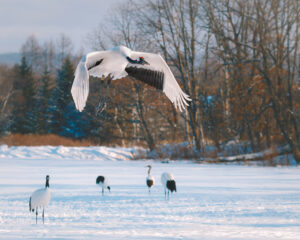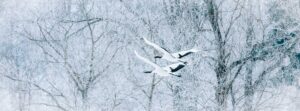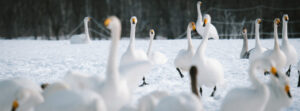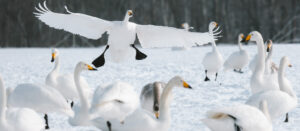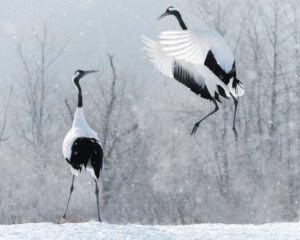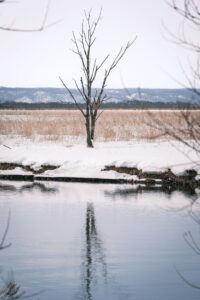A Winter Photography Guide to Kushiro: Red-Crowned Cranes, Eagles & the Frozen Wetlands

The Kushiro area in eastern Hokkaido is one of Japan’s best destinations for wildlife photography, offering vast, untouched landscapes and a rich variety of wildlife. At its heart lies the Kushiro Shitsugen National Park, home to Japan’s largest wetland, covering approximately 268 square kilometers (103 square miles). This expansive wetland ecosystem supports diverse species, including red-crowned cranes, Ezo red foxes, Ural owls, Sika deer, Steller’s sea eagles, and white-tailed eagles. The area’s harsh winters create a striking contrast between the frost-covered landscape and the vibrant wildlife, making it a dream location for photographers.
Among the many species found here, the red-crowned crane (Grus japonensis) stands out as an iconic symbol of Japan. Revered in Japanese culture, it is considered a national treasure, often depicted in art and folklore as a symbol of longevity, luck, and fidelity. However, due to habitat loss and overhunting in the past, the population of these cranes declined drastically, making them almost extinct in Japan by the early 20th century. While they once thrived across the country, today they are almost entirely limited to Hokkaido, with only a few scattered individuals seen on Honshu.
In an effort to support the remaining population, local farmers in the Kushiro area began feeding the cranes during the winter when food is scarce. This practice, along with strict conservation measures and wetland protection, has helped the population recover to over 1,800 individuals in Hokkaido. Today, winter is the best time to observe and photograph these magnificent birds as they gather in open fields and feeding sites, performing their elegant courtship dances in the snowy landscape.
The Ethics of Feeding Red-Crowned Cranes
Feeding red-crowned cranes in Hokkaido has played a crucial role in their recovery, helping their population rebound from near extinction. However, this practice also raises ethical concerns. Critics argue that reliance on human feeding has led to unnatural behavior changes, such as year-round residency in Hokkaido instead of seasonal migration. Large gatherings at feeding sites also increase the risk of disease transmission and potential conflicts with farmers as cranes seek food beyond designated areas.
On the other hand, supporters highlight that feeding has been a lifeline for the species, stabilizing their numbers and allowing people to observe and appreciate them, which in turn promotes conservation awareness. Some conservationists suggest gradually reducing dependence on feeding while restoring wetland habitats so cranes can forage naturally. While the debate continues, it’s clear that both conservation efforts and careful management are necessary to ensure a sustainable future for these iconic birds.
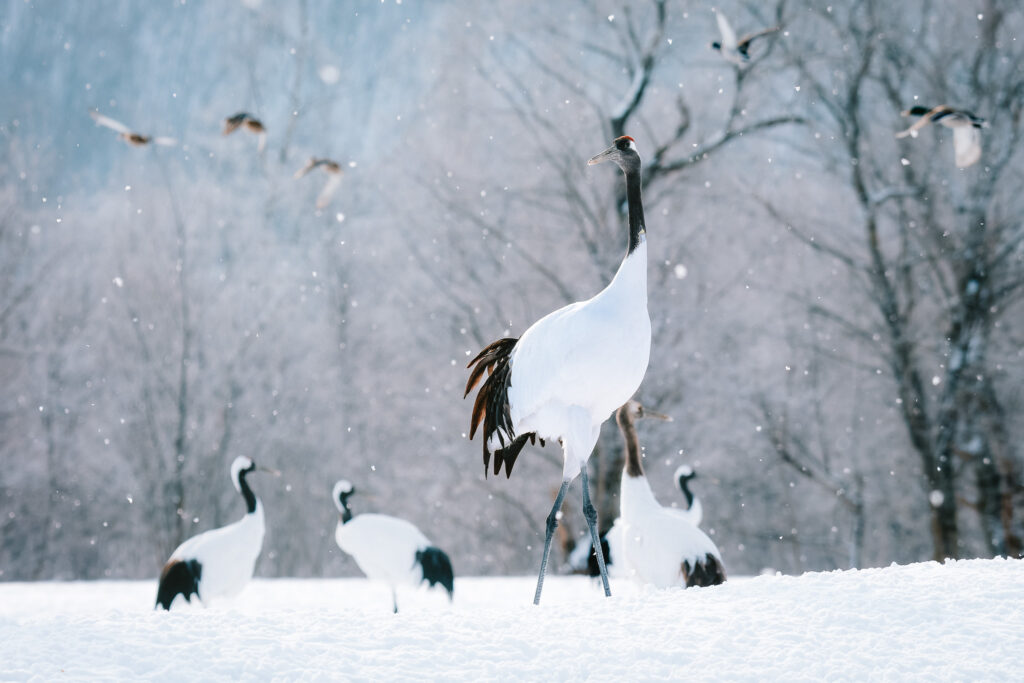
My Trip to the Kushiro Wetlands
I visited the Kushiro Wetlands for two days in February 2023, driving across from my home base in Niseko. For those coming from other parts of Japan or abroad, the easiest way to get there is by flying into Kushiro Airport, which has domestic connections from Tokyo and other major cities.
The best places to stay for wildlife photography are Tsurui or Akancho, as they are closer to the main crane-viewing locations. However, accommodation in these areas is limited and books up quickly, and since I was late to reserve, I ended up staying in Kushiro City, about a 45-minute drive from the main crane sites but still near the wetlands. While not as convenient, Kushiro City is a small but pleasant city with good hotel and restaurant options.
Day 1: Akan International Crane Center
For my first location, I decided to check out the Akan International Crane Center in the morning. Their website lists an opening time of 9:00 AM, so I arrived a little early, only to discover that the viewing area is accessible before opening hours, which is great for catching golden-hour light. Unfortunately, the weather was overcast, so I didn’t get that beautiful soft morning glow, but I still made the most of the opportunity.
The center has a viewing area with access to two fields. The first field, near the entrance, was filled with whooper swans and a few red-crowned cranes, while the second field had a much larger gathering of cranes. Seeing them for the first time, I was surprised by how tall they were—standing at around 150 cm (5 feet). They were elegant and majestic, and as I observed them, I noticed pairs beginning to dance, performing their elaborate courtship displays. It was incredible to watch—jumping, bowing, and calling to each other. Every now and then, a few cranes would take off or come in for a landing, their huge wingspans—up to 220 cm (7 feet)—stretching across the sky.
This was the perfect place to practice action photography—capturing the cranes dancing, taking off, and flying. Even though the light was flat, I started shooting, using my Fujifilm X-H2S with a Tamron 150-500mm lens. To freeze their motion, I set my shutter speed to 1/1000 sec, kept the aperture wide open (f/5-6.7, depending on my zoom level), and used Auto ISO with a max limit of 6000—though the highest it reached that morning was around 1000.
To improve my compositions, I moved around the viewing area, experimenting with different angles and heights. I found that getting lower to the ground helped reduce the boring, snowy foreground and instead gave me a darker, more contrasting background from the distant trees. However, due to the slightly hilly terrain, this wasn’t always possible.
Interestingly, most of the 10-20 other photographers there stayed in the same spot, using tripods at head height. Meanwhile, I was lying flat on the ground, trying to get a unique angle through gaps in the fence. I got some puzzled looks, which I found amusing, but I think the lower perspective made a difference in creating more striking images.
After a few hours, my memory cards were filling up, so I decided to head back to my car, offload the photos, and explore some other wildlife locations in the area.

Scouting Otowa Bridge for Sunrise
My next stop was Otowa Bridge, which crosses the Setsuri River. This location is famous for sunrise crane photography, as the river doesn’t fully freeze in winter, creating mist rising from the water. Many cranes nest and sleep here overnight, and in the morning, they can be seen standing in the misty river—a dream shot for many wildlife photographers.
However, Otowa Bridge is extremely popular, and I had heard that to get a good shooting spot, you need to arrive extra early, sometimes hours before sunrise. Given the cloudy forecast and the potential crowds, I decided to skip it this time and save it for another visit.
Finding an Ezo Owl
A friend had given me a vague tip about the location of an Ezo owl, saying that it was near a certain farm in Tsurui. With nothing more than that, I checked the map, found the farm, and drove there. Unsurprisingly, the area was full of trees, making the search feel like looking for a needle in a haystack.
However, just a few hundred meters past the farm, I noticed several parked cars at the side of the road, with footprints disappearing into the forest. I drove a little further but then decided to turn around and take a closer look. As I came back, I saw a photographer with a big camera leaving—a promising sign.
I parked on the roadside and followed the footprints into the forest. Five minutes later, I found it—an Ezo owl, perched inside a large tree hole across a small creek. Seeing this majestic owl sitting in its natural home was a special moment. Every now and then, it would slowly turn its head, but for the most part, it sat perfectly still, blending into the tree bark.
I set up my tripod and tried different compositions, from tight portraits to wider shots that included the surrounding trees. Since the owl wasn’t moving much, I lowered my shutter speed to let in more light, allowing me to use a narrower aperture for better image sharpness. This also helped keep my ISO lower, reducing noise, as the valley where the owl was sitting was fairly dark.
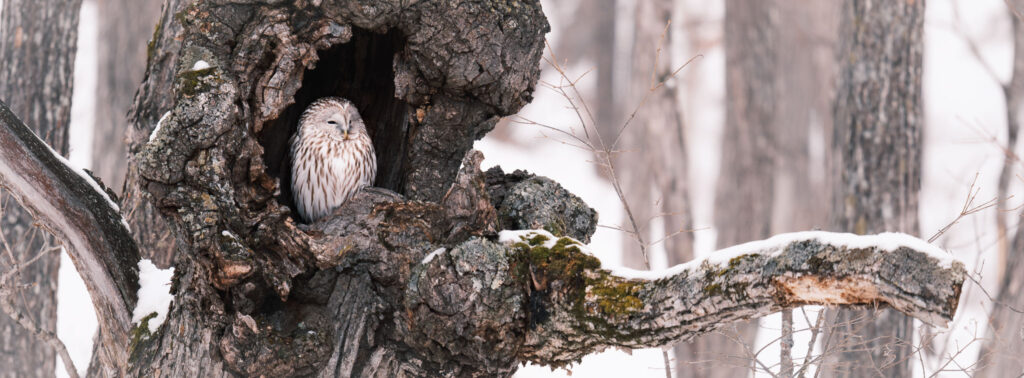
Afternoon at Tsurumidai Crane Observatory
Later that afternoon, I visited Tsurumidai Crane Observatory, another well-known location for observing red-crowned cranes. Here, many cranes were flying in and out of the field, some soaring low overhead, giving me an incredible perspective on just how massive their wingspans were. Seeing them pass so close made it easy to appreciate their grace and power in flight.
This spot turned out to be one of the best places to capture in-flight shots, as the cranes regularly took off and landed at close range. I spent a few hours experimenting with different autofocus settings on my camera to see which worked best for tracking birds in flight. The combination of changing light conditions, varying flight angles, and fast movement made it an excellent opportunity to fine-tune my autofocus and tracking techniques.

Day Two: A Perfect Morning at Akan Observatory
The next morning, I planned to return to the Akan International Crane Center earlier than the previous day to take advantage of the better morning light. Unfortunately, I got delayed on the way and arrived a bit later than planned—around 8:00 AM—just as they started feeding the cranes.
As soon as I arrived, the scene was alive with movement—cranes were flying in, jumping, and competing for food. The light was perfect—the sun had broken through, yet it was still lightly snowing, with a thin layer of fresh snow covering the trees in the background. The entire landscape was sparkling, creating an almost ethereal, dreamlike atmosphere.
Knowing this was a rare opportunity, I positioned myself as low as possible, pointing my camera toward a high point in the field where I anticipated the cranes would move. I didn’t have to wait long—a pair of cranes stepped into the perfect spot and began to dance. They moved in sync, their long necks intertwining as they called to each other, their breath visible in the cold air. This was exactly the moment I had hoped for, and I captured one of my favorite shots of the trip.
Capturing the Moment – Camera Settings & Technique
Photo 1: The Dancing Cranes
– Fujifilm X-H2S + Tamron 150-500mm lens at 220mm
– Manual Mode: 1/1000 sec | f/6.3 | ISO 320
– Focus Mode: Continuous AF (C-AF) with subject tracking
I chose 1/1000 sec shutter speed to freeze their movement as they danced. The f/6.3 aperture provided a good balance between depth of field and sharpness while allowing enough light to keep the ISO low at 320 for a clean, detailed image. The softly blurred background helped the cranes stand out beautifully against the snowy landscape.
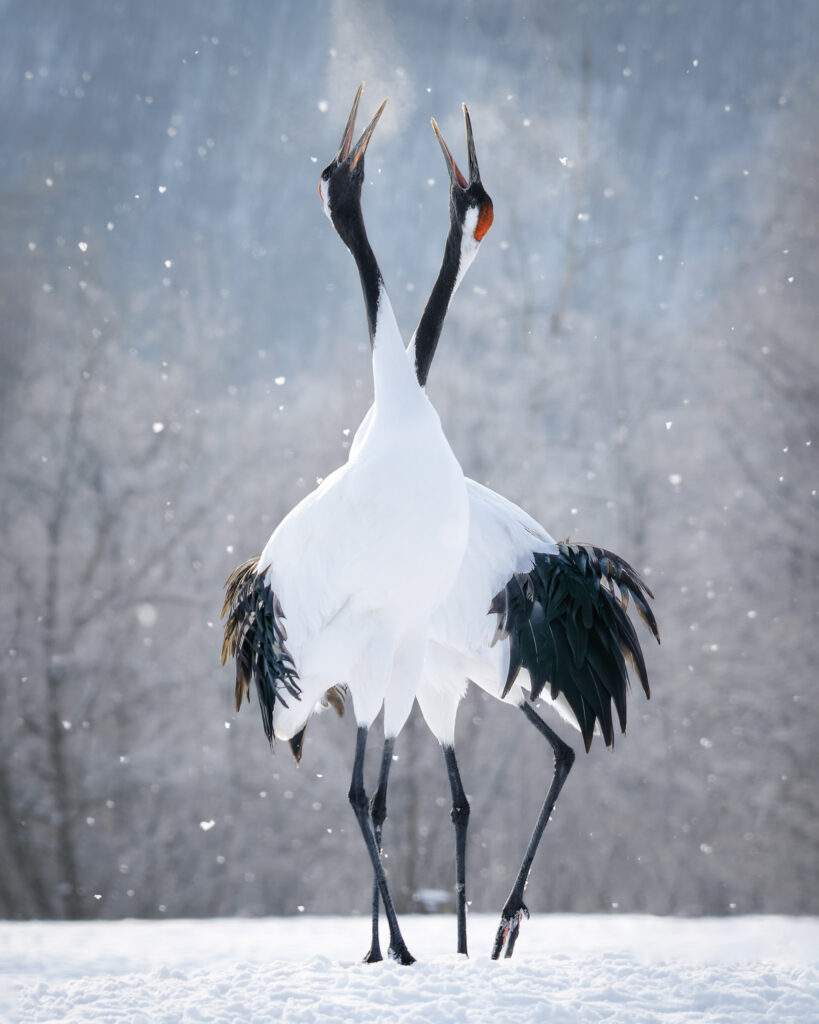
Photo 2: Jumping Crane in Flight
– Fujifilm X-H2S + Tamron 150-500mm lens at 207mm
– Manual Mode: 1/1250 sec | f/5.6 | ISO 250
For the second shot, I noticed a crane suddenly leaping high into the air, its wings fully extended as it displayed for its mate. I increased the shutter speed to 1/1250 sec to ensure sharpness in the wings. To compensate for the faster shutter speed and keep ISO low, I used f/5.6, which allowed in more light. This also helped keep the background slightly softer, ensuring the crane remained the clear focal point of the image.
These shots stood out as some of the best from the trip, thanks to the combination of ideal lighting, snowfall, and action. Seeing these graceful birds interacting in their winter habitat was an unforgettable experience, and the conditions couldn’t have been better for photography.

Exploring the Kushiro Wetlands
That afternoon, I decided to take a detour and explore some random back roads leading into Japan’s largest wetland, hoping to see what wildlife I could find. The Kushiro Wetlands, covering over 268 square kilometers, are home to an incredible variety of species, from birds of prey to small songbirds, foxes, and deer. In winter, the landscape transforms into a frozen, otherworldly wonderland, with vast open plains, snow-covered reeds, and winding rivers creating a scene that feels almost untouched by time.
Before I even made it into the back roads, I had a lucky sighting—a Steller’s sea eagle perched high on a lamppost. This was my first chance on the trip to photograph one up close. With their massive size, bold black-and-white plumage, and bright yellow beak, these eagles have a commanding presence. I stopped the car and watched for a while, hoping to capture the moment when it would take off. After waiting patiently for ages, I mistimed its flight and missed the shot of it launching into the sky—a frustrating but common experience in wildlife photography! Still, I was happy to have captured some solid portraits of this majestic bird.
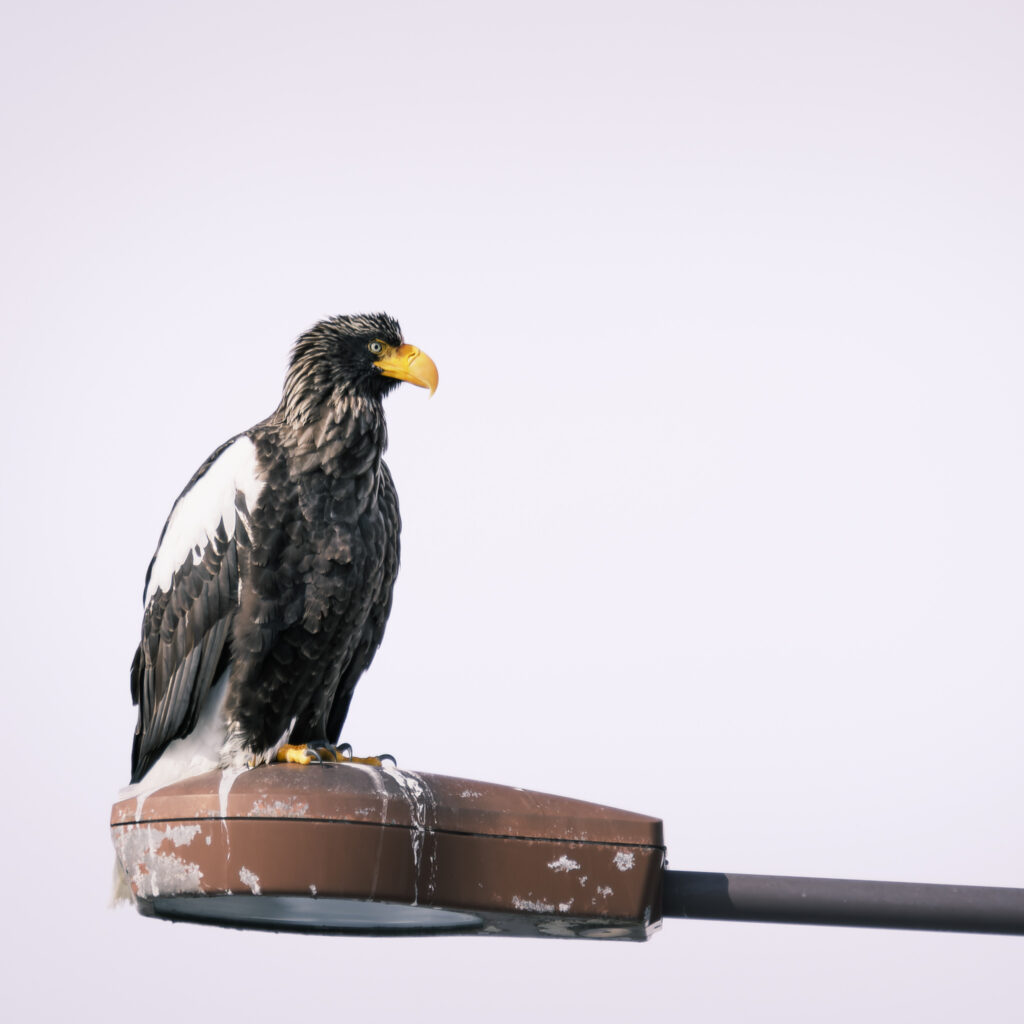
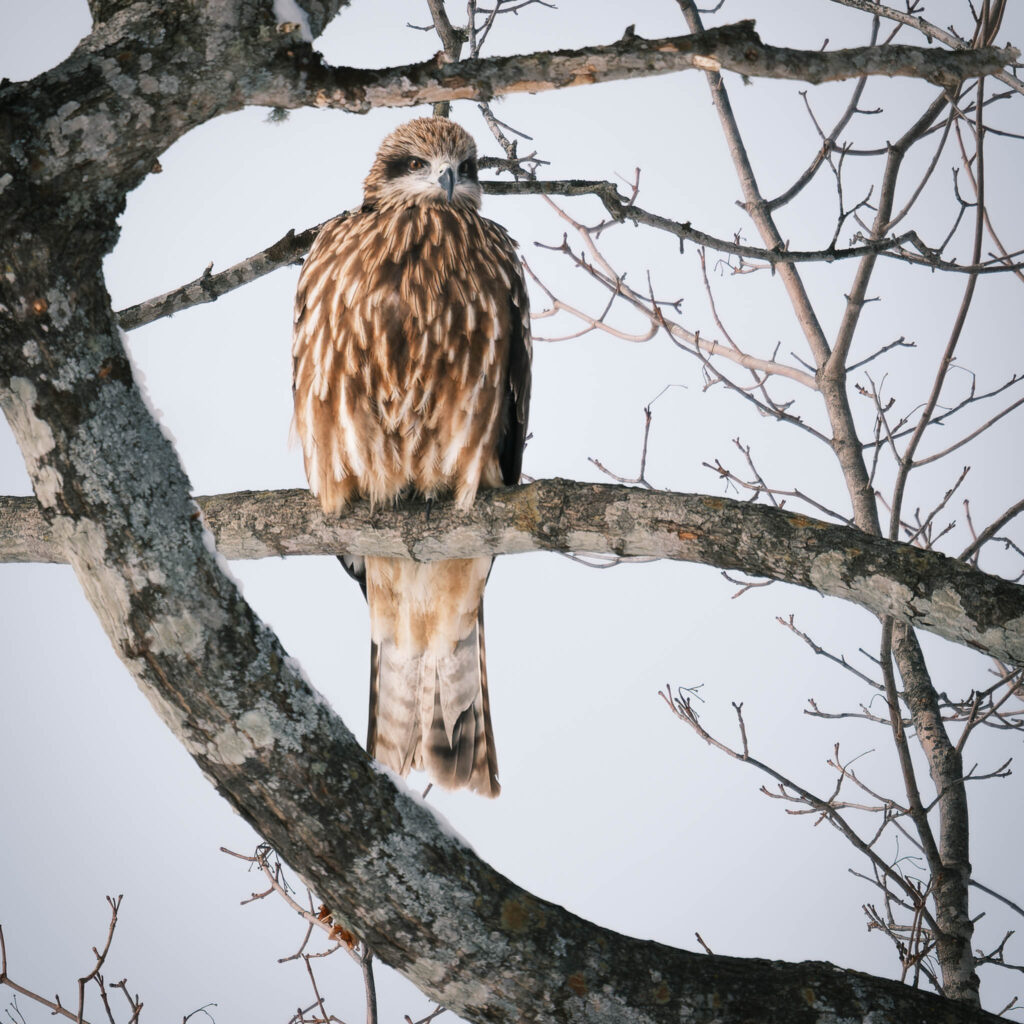
As I drove deeper into the wetlands, I came across a cluster of old trees standing beside a slow-moving river. The contrast between the leafless, skeletal branches and the still, reflective water made for a striking composition, so I stopped to take a few landscape shots. The scene felt completely tranquil and untouched, with no other people around—just the soft sound of the wind moving through the reeds.
Nearby, I spotted an Eastern Marsh Harrier perched on a branch, scanning the frozen fields below for prey. Harriers are incredible hunters, often seen gliding low over wetlands in search of small mammals or birds. This one was stationary, giving me time to take a few portraits before it eventually took flight. Catching it in motion against the pale winter sky was another rewarding moment.
Aside from the larger birds, I also noticed flocks of small songbirds, including Shima Enaga (the Japanese long-tailed tit) and woodpeckers tapping away at the trees. There were also Hokkaido red foxes and Sika deer roaming the open fields, but I wasn’t able to get good photos of them this time.
The Kushiro Wetlands were a fascinating place to explore, offering a mix of landscape photography and wildlife encounters. Even in winter, when much of the area is frozen and quiet, there was still plenty of life to be found for those willing to take the time to look.

Final Thoughts
Visiting the Kushiro area in winter was a unique and rewarding experience, offering incredible opportunities to photograph Japan’s diverse wildlife in a stunning, frozen landscape. From the elegant red-crowned cranes dancing in the snow to majestic eagles and elusive owls, every moment felt like a glimpse into one of Japan’s most pristine natural environments. While the conditions could be challenging, the beauty and abundance of wildlife made it well worth the effort. For any photographer or nature enthusiast, the Kushiro area in winter is a destination that shouldn’t be missed.
